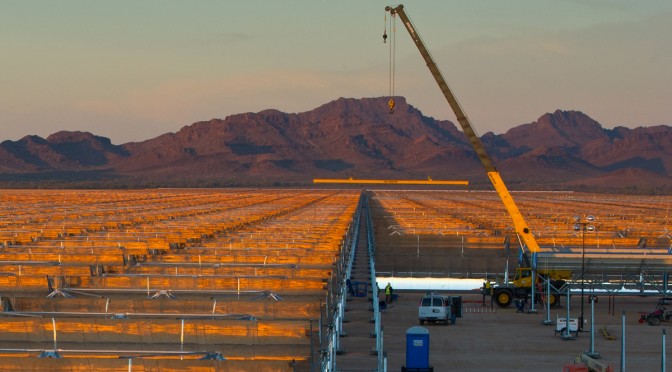Unlike other solar-powered electrical plants, the new Solana Concentrating Solar Power (CSP) keeps the sun's energy working after dark to produce electricity for APS customers across Arizona.
Unlike other solar-powered electrical plants, the new Solana Generating Station keeps the sun's energy working after dark to produce electricity for APS customers across Arizona. The three-square-mile facility near Gila Bend, Ariz., uses concentrated solar power (CSP) technology and thermal energy storage to capture the sun's heat to generate clean, renewable electricity. (Photo: Business Wire)
Solana represents an important technological advance in solar energy production compared to the more-common photovoltaic technology, which needs direct sunlight in order to produce electricity. The three-square-mile facility near Gila Bend uses concentrated solar power (CSP) technology and thermal energy storage to capture the sun's heat to generate clean, renewable electricity.
This technology enables Solana to produce electricity at full capacity for up to six hours after sunset, including the early evening hours when customer demand for power typically peaks in Arizona.
“Solana is a monumental step forward in solar energy production,” said Don Brandt, APS President and Chief Executive Officer. “Solana delivers important value to APS customers by generating power when the sun isn't shining. It also increases our solar energy portfolio by nearly 50 percent. This provides a huge boost toward our goal to make Arizona the solar capital of America.”
Solana is one of the largest power plants of its kind in the world with a capacity of 280 megawatts, enough to provide energy for 70,000 Arizona homes – a city the size of Yuma. APS is purchasing 100 percent of the output from Solana, which was constructed and is owned by Abengoa Solar.
The plant's CSP technology produces electricity by collecting the sun's heat to create steam that turns conventional turbines. The process begins with 2,700 parabolic trough mirrors, which follow the sun to focus its heat on a pipe containing a heat transfer fluid. This fluid, a synthetic oil, can reach a temperature of 735 degrees Fahrenheit. The heat transfer fluid then flows to steam boilers, where it heats water to create steam. The steam drives two 140-megawatt turbines to produce electricity, much like a traditional power plant.
%%anc%%
What separates Solana from other solar power plants is the ability to store the heat from the sun up to six hours for electrical production at night. In addition to creating steam, the heat transfer fluid is used to heat molten salt in tanks adjacent to the steam boilers. The thermal energy storage system includes six pairs of hot and cold tanks with a capacity of 125,000 metric tons of salt, and the molten salt is kept at a minimum temperature of 530 degrees Fahrenheit.
When the sun goes down, the heat transfer fluid can be heated by the molten salt to create steam by running it through the tanks instead of the field of parabolic mirrors.
“With Solana's substantial thermal heat storage capacity, we can manage electrical output from the plant much more effectively than from other solar power sources,” said Pat Dinkel, APS Vice President of Resource Management. “With photovoltaic technology, generated electricity needs to be used immediately or it's lost. Solana's technology extends the use of solar energy to produce power whenever our customers need it most, including evenings.”
With the addition of Solana, APS will have 750 megawatts of solar power on its system by the end of 2013, enough to serve 185,000 Arizona customers.
APS, Arizona's largest and longest-serving electricity utility, serves more than 1.1 million customers in 11 of the state's 15 counties. With headquarters in Phoenix, APS is the principal subsidiary of Pinnacle West Capital Corp. (NYSE: PNW).


